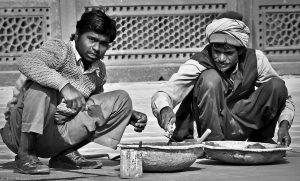On August 8, 2020, Mukesh Ambani became the fourth richest man in the world. The same day, a laborer in Madhya Pradesh who had lost his job after the coronavirus-induced lockdown killed himself and his three daughters by tying the girls to his waist and jumping into a well.
This is a tale of two Indias and the broadening economic inequality between them.
In the last two decades, inequality in India has grown faster than in any other country except Russia. Oxfam’s 2019 “Time to Care” report found that the richest 1 percent of Indians held more than four times the wealth held by the bottom 70 percent of the country – that is, four times the wealth of 953 million people.
In the last five months during the coronavirus pandemic, Mukesh Ambani, Asia’s richest man and the chairman of the Reliance group, amassed over $48 billion in net worth, according to the Bloomberg Billionaires Index. His net worth has doubled to over $80 billion in just the past year.
At the same time, the International Labor Organization (ILO) estimated that nearly 400 million workers in India’s informal economy are at risk of falling deeper into poverty. According to the Centre for Monitoring Indian Economy, over 18.9 million salaried people lost their jobs since April 2020 — 5 million in July alone.
An August 31 report by the Indian government found that the economy has contracted by 23.9 percent in the first quarter, marking the beginning of a deep recession. Defying its long-term accelerating trend, the economy was already slowing in India, a situation exacerbated by the COVID-19 pandemic. Real GDP growth in India had fallen from 7.0 percent in 2017-18 to 6.1 percent in 2018-19 and 4.2 percent in 2019-20.
Brutal and abrupt lockdown restrictions to curtail the spread of the coronavirus in March and April led to countless job losses and an internal migration crisis. On the supply end, based on the NSSO report for the first quarter, the gross value added (GVA) growth for all sectors except agriculture declined steeply. On the demand side, the two biggest engines of growth in India, consumption and investment, which accounted for over 88 percent of the total GDP, are faltering. Government spending, while increasing a little over this period, is nowhere able to compensate for the loss of demand. The Indian government simply lacks the capacity to spend its way out of this crisis.
Economist S. Subramanian proposes levying a 4 percent wealth tax on India’s 953 richest families, which would give the government the equivalent of 1 percent of India’s GDP to spend – greater than the financial package announced by the government to combat COVID-19 in April.
OXFAM reports that the cumulative wealth of just 63 rich people in India was greater than the entire Union government budget for 2018-2019. As an OXFAM report noted, “Billionaires’ fortunes increased by almost 10 times over a decade.”
One of the major reasons for India’s widening inequity is its tax policies, which already skewed toward favoring the rich over the poor. In the Union Budget of 2016-2017, the Narendra Modi government abolished the wealth tax that had been there since 1957. It was replaced by an extra 2 percent surcharge on those with taxable income over 10 million Indian rupees. Later, the government also rolled back this surcharge in 2019 for foreign and domestic investors. Additionally, base corporate taxes were reduced to 22 percent from 30 percent to attract investment.
With direct tax collections reduced, indirect taxes in terms of cesses, like the Swachh Bharat and Krishi Kalyan cess, and surcharges were raised to compensate for the loss in tax revenue – impacting the poor a lot more than the rich. The heavy reliance on increased indirect taxes has not made up for the direct tax revenue loss, leading to a rise in fiscal deficit beyond 4.5 percent of GDP in 2019-20. This partly explains the stagnation in public spending on education and health.
Ila Patnaik and Rajeswari Sengupta estimate that tax revenues this year may decline by about 12.5 percent as a whole due to reduced economic activity during ongoing COVID-19 crisis. Government revenue through the Goods and Services Tax for August 2020 is already 12 percent less than that in August 2019. There is an urgent need for more government spending to reduce the tragic impact of this pandemic on millions of Indians and one effective way is to raise taxes on the few super rich — a COVID cess, as proposed by some in the Indian Revenue Service.
The stagnation in public spending on health care has become even more detrimental as the coronavirus pandemic ravages India, affecting over 4.5 million people, with India reporting more daily COVID-19 cases than any other country in the world at the end of August. India’s spending on public health care is among the lowest in the world. Almost 120 people every minute are being pushed into poverty in India because of health care costs, a situation worsened by the recent wave of health care privatization.
India’s most vulnerable are moving from poverty to hunger. In 2019, 14.5 percent of India’s population — 195 million people – were malnourished, largely due to extreme inequality. An OXFAM India survey found that half of the rural households were having to cut back on their meals five weeks after the Indian government instituted a 21-day lockdown.
The World Bank has noted that India is at risk of losing many of its hard-won gains against poverty. In its 2020 India Development Update in July, the World Bank noted that half of India’s population is vulnerable with “consumption levels precariously close” to the poverty line.
Meanwhile, the Indian rich continue to become obscenely richer.
































